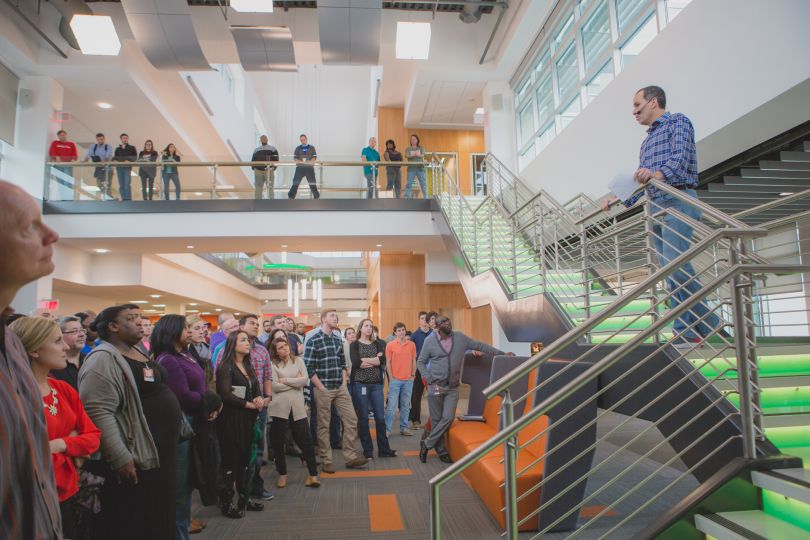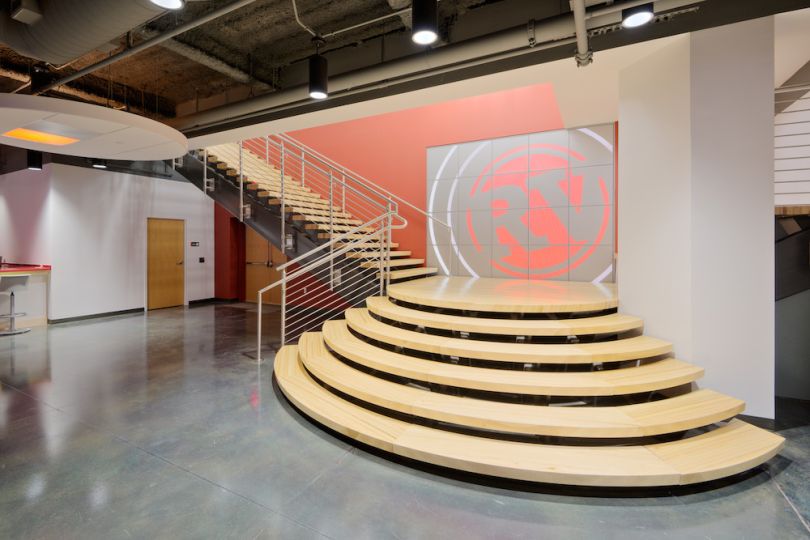Lucas Allen knows how difficult it can be to get into tech mid-career. While working as a high school math teacher in Central Illinois, he crammed nearly a year’s worth of Coursera data science classes into his four-month summer break to qualify for the jobs he wanted.
For Allen, the hardest part of that experience wasn’t managing the course load or understanding the nuances of neural networks — it was doing it alone.
“It was hard to do that by myself without a sounding board, without any other fellow students or mentors to guide me through the process,” said Allen, who now works as a data scientist for Red Ventures. “That’s what makes it challenging to go through a [massive open online course] program like that.”
So when Allen joined Red Ventures and heard that the company ran a development program for employees interested in becoming data analysts and scientists, he knew he had to get involved.
“When the data scientist who had been running it approached me and a couple others [to run it], I stepped forward and said, ‘This is an exciting program, and I’d love to be a part of it.’”
Allen leads the program alongside a few colleagues. Their job is to help shepherd students through the journey of becoming a data professional, from learning the basics of Python to building their own data models, and eventually apprenticing on the team.
In doing so, the program has helped employees make a leap into a new career track and address Red Ventures’ need for data talent.
With companies across the country struggling with a lack of data talent, it’s also given Red Ventures an edge in growing its team.

Building an internal pipeline to solve a talent shortage
In 2016, Red Ventures faced a challenge nearly all fast-growing tech companies experience: they needed to quadruple the size of their five-person data team, fast.
Since data was an emerging field, the company knew it would be difficult to grow solely with external hires, Allen said. So, they researched how other companies were handling this challenge and what resources were available. When they stumbled on the trove of online courses out there, they started kicking around the idea of building their own accelerator.
“There’s an advantage to giving people that sustainable nudge in the beginning, and it’s a chance for them to see our team culture up close.”
Rather than simply paying for employees to attend courses on their own, they’d cultivate talent internally, provide support along the way and train them to use Red Ventures’ tools.
“Our [learning and development department] could help us make this entirely a self-service program, but we feel like there’s a lot of value in the face-to-face,” Allen said. “There’s an advantage to giving people that sustainable nudge in the beginning, and it’s a chance for them to see our team culture up close.”
To that end, the data team facilitates every aspect of the course. Initially, Red Ventures Data Scientist Keith Williams and a few others in data ran it, but they eventually spread out the responsibilities to balance the load. Now, data scientists and analysts volunteer to form a faculty. Some sign up to lead lessons, others make themselves available for office hours or serve as mentors.

Creating a support network through the classroom
The accelerator mimics a college curriculum, with a 100-level covering the basics, a 200-level covering advanced skills and a 300 level, where students apprentice on the data team. From start to finish, students can graduate in about seven months and join the data team.
Any Red Ventures employee is eligible to sign up for the program as long as they’ve worked there for at least a year and their managers sign off. Almost everyone has at least a couple transferable skills to become a data scientist or analyst — they just need a push, Allen said.
The first two levels of the accelerator involve a couple of large-group lectures, breakout classes with smaller groups, and self-study videos and assignments. The team uses the lectures to give students insight into Red Ventures-specific tools and methods, while smaller weekly sessions are held to provide an opportunity for students to ask questions, do code review and work together.
At the 100 level, students spend two months getting a sampling of what a data scientist or analyst does. They learn some Python coding fundamentals, some version control and how to do the basics of data analysis and visualization. At the end, they get an introduction to modeling techniques.
“If they’re interested in a career change, they have the opportunity to make that known and go into the 300 level.”
Allen said the joint sessions are most valuable at the early stages, where students often need support to get over the learning curve hump.
“That’s the time when people are most susceptible to drop out because they feel the most overwhelmed — particularly if they don’t have a background in writing code or mathematics,” Allen said.
The second stage of classes puts those skills to use. Anyone interested in continuing on at that stage is usually interested in becoming a data scientist or analyst. At this point, they spend most of the time putting together a final analysis solving a problem at Red Ventures.
“At the end of that two months, they present their problem that they’ve solved to a panel of data analysts and data scientists,” Allen said. “If they’re interested in a career change, they have the opportunity to make that known and go into the 300 level.”
In the final stage, students spend three months working full time as a data scientist or analyst, as both sides evaluate the fit. About three people a year graduate from the program and complete the transition, but the new hires often bring extensive experience working at Red Ventures and perspective from their old roles, whether that’s as a business analyst or copywriter.

Fostering team growth and professional development
While the company initially established the accelerator to help people make a career jump, the introductory level has proven a hit for anyone interested in learning what the data team does. Directors, managers and vice presidents have taken the 100-level course to better understand the data team’s work.
“Not everybody is interested in career change, and we’ve become more aware that, with each passing year, a lot of people are just interested in either skilling up in their current roles or being able to do better analysis with open source tools,” Allen said.
“Whenever you can have a program that brings in a diversity of opinions and backgrounds, it’s to the benefit of the team.”
But it’s also helped Red Ventures build a more diverse data team with a wider array of backgrounds. The group now includes about 25 people in data science and analysis roles, with nearly half coming from the accelerator program.
It’s not always easy to make that leap from non-tech to tech. Through their course, Allen and his colleagues hope to demystify the work of data professionals and grow their own team along the way.
“We’ve had people come from a variety of roles,” Allen said. “Sometimes people have used it to transition from a data analyst role to a data scientist role, others have used it to make a [complete] career change.”
“Whenever you can have a program that brings in a diversity of opinions and backgrounds, it’s to the benefit of the team,” he added.




